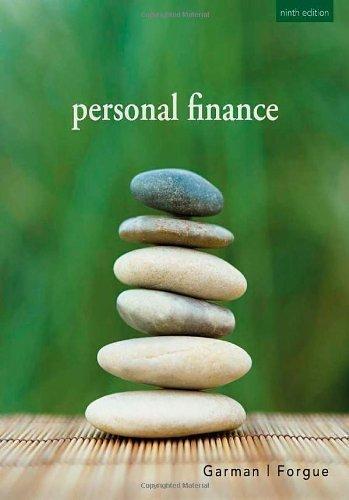Question
1. Table 1 shows three alternative options for a $20k up-front investment. Table 1. Year Cow/Calf Grain Irrigated 0 -$20,000 -$20,000 -$20,000 1 $2,000 $5,800
1. Table 1 shows three alternative options for a $20k up-front investment.
| Table 1. | Year | Cow/Calf | Grain | Irrigated |
|
| 0 | -$20,000 | -$20,000 | -$20,000 |
|
| 1 | $2,000 | $5,800 | $10,000 |
| 2 | $4,000 | $5,800 | $8,000 | |
| 3 | $6,000 | $5,800 | $6,000 | |
| 4 | $8,000 | $5,800 | $3,000 | |
| 5 | $10,000 | $5,800 | $1,000 |
What is the IRR of the Cow/Calf investment? Enter your answer as a percentage to the nearest whole number (e.g., 7%)
2.What is the IRR of the Grain investment? Enter your answer as a percentage to the nearest whole number (e.g., 7%)
3.What is the IRR of the Irrigation investment? Enter your answer as a percentage to the nearest whole number (e.g., 7%)
4.which investment has the largest TOTAL NET RETURN?
5. Which investment would be preferred based on the IRR method?
6. Which of the following are criticisms of IRR? Select all that apply.
| It does not account for the time value of money. | ||
| It can end up assuming returns can be reinvested at unrealistic rates. | ||
| It cannot handle investments with more than one period of negative net returns. | ||
| It cannot be used to determine if an investment will be adopted by an investor or not. |
7. Suppose you analyzed a $40k investment using a 7% discount rate, 2% inflation rate, and 3% reinvestment rate and got the following results in Excel.
|
| $40k Investment |
| |||
| Year | Revenues | Costs | Net Return | PV of Returns | FV of Returns |
| 0 | $0 | $40,000 | -$40,000 | -$40,000 | - $46,371 |
| 1 | $500 | $0 | $500 | $458 | $563 |
| 2 | $2,000 | $0 | $2,000 | $1,679 | $2,185 |
| 3 | $5,000 | $0 | $5,000 | $3,846 | $5,305 |
| 4 | $6,500 | $0 | $6,500 | $4,581 | $6,695 |
| 5 | $47,500 | $0 | $47,500 | $30,674 | $47,500 |
| Total | $61,500 | $40,000 | $21,500 | $1,239 | $15,877 |
What is the sum of the Future Values of POSITIVE returns to the investment (this is the numerator inside the root function in the MIRR formula)?
8. What is the sum of the Present Values of all NEGATIVE returns (this is the denominator in the MIRR formula)? Enter your answer as a positive number.
9. What is the Future Value of the $5000 return earned in Year 3 if it can be reinvested at 3%?
10. What is the MIRR of this investment? Enter your answer as a percent to one decimal place (e.g,, 10.5%)
Step by Step Solution
There are 3 Steps involved in it
Step: 1

Get Instant Access to Expert-Tailored Solutions
See step-by-step solutions with expert insights and AI powered tools for academic success
Step: 2

Step: 3

Ace Your Homework with AI
Get the answers you need in no time with our AI-driven, step-by-step assistance
Get Started


